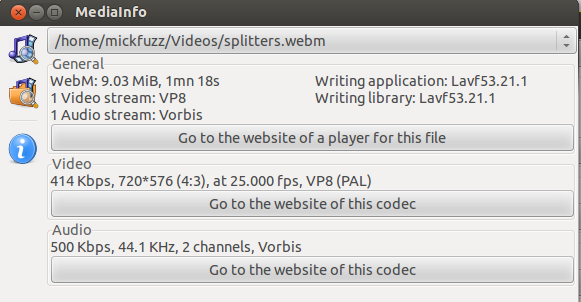A Look at Open Video
Understanding Video Files
This task aims to give an introductory look at what makes up a video file. To do this we will download a video file and take a look at what is inside.
By the end of this task you should be able to:
- Understand that video files can have different streams
- Use a programme to find out more information about these streams
Tools you will need for this task:
- Internet Connection
- Mediainfo - available for Mac, Linux & Windows

Step one: Download a Video File
Download a video file in WebM format. If in doubt, you can use the one listed in the last task. Download WebM video clip
We can play this file on our desktop using an video playing application like VLC. However, just playing the file doesn't help us to really understand what is inside it. To find out more we will use another Free Software programme called Media Info. You can download Mediainfo from here.
Using MediaInfo to investigate the anatomy of video files
When you have installed MediaInfo launch it and you should get an interface like the one shown below.

Let's open one of our video files by clicking on the Open File icon or selecting File > Open > Open File(s) from the menu.

When we open the video file MediaInfo reads the file but instead of playing the video it displays information about it.

The General section here gives us the following information
WebM: x.xxMiB, xmn xxs
1 Video Stream: VP8
1 Audio Stream: Ogg Theora
This information will be useful to us later in this course when we start to work with video files. It is also useful right at the start to understand the parts video files are made up of.
WebM here describes the video container. Popular video containers include .mp4, .mov, .avi. Containers themselves don't contain any video or audio content, they are the vehicle in which that content travels.
We can see that the WebM container here has one video stream and one audio stream.
Sometimes we can have files that contain many different video and audio streams, this can be particularly useful if we have a film with different audio streams in different languages. We can see this in the video file listed below.

The information of the video above shows us a video file using the Matroska container (.mkv). This container allows you to add more than one audio stream.

Codecs and Containers
Each stream that we see here has audio or video information that is compressed using codecs. We learn much more about codecs and containers in the following chapters. Right now we just need to understand that they are used to compress media data so that it takes up less space.
Popular video codecs include h264, vp8, mpeg2.
Popular audio codecs include ac-2, ogg theora and mp3.